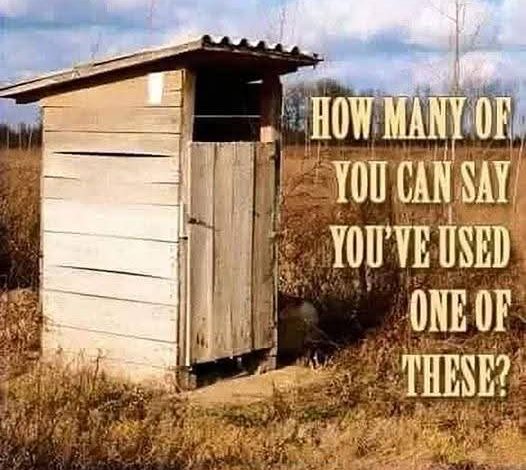The Outhouse: A Reminder of Simpler Times

ADVERTISEMENT
The Outhouse: A Reminder of Simpler Times
Introduction:
The image of a rustic outhouse might seem a bit odd or amusing in today’s world of modern plumbing, but it brings forth memories of a time not too long ago when people lived in ways that required more effort and ingenuity. The question posed in the image—”How many of you can say you’ve used one of these?”—invites a reflection on the changes in our everyday lives, particularly when it comes to basic necessities like sanitation. This question doesn’t just invoke humor; it sparks a sense of nostalgia and prompts us to appreciate the advancements in technology and infrastructure that many of us take for granted today.
A Look Back at the Outhouse: Before modern plumbing became a standard feature in homes, many rural areas and small communities relied on outhouses as their primary form of sanitation. These simple structures, often made from wood and located in a distant corner of the yard, were designed to be used as outdoor toilets. Inside, they typically featured a basic seat above a deep pit, and many people would need to venture out in all types of weather to use them.
The outhouse was more than just a toilet; it was a part of daily life for people in these earlier generations. It required a certain amount of planning to maintain it, as it needed to be emptied periodically and kept relatively clean. For children, using the outhouse was a rite of passage—a task that brought with it a bit of discomfort but also a sense of independence. The memories of walking out to the outhouse at night or during a snowstorm remain vivid for those who grew up in homes without indoor plumbing.
How the Outhouse Shaped Society: While the outhouse may seem like a relic of the past, it was a necessity for many communities and served as a reminder of simpler, self-sufficient times. It taught people to be resourceful and to work together as a community. In the absence of modern facilities, maintaining a clean and functioning outhouse became an essential part of life.
ADVERTISEMENT
The outhouse also held a certain level of dignity. Though it may not have been the most glamorous structure, it provided a necessary service and was often part of a larger, carefully managed homestead. People took pride in ensuring their outhouse was in good condition, and often, families would decorate the surrounding area or build a garden near it, making it a functional yet somewhat pleasant part of their property.
The Advancements That Followed: In the 20th century, the development of indoor plumbing revolutionized sanitation and drastically improved quality of life. The advent of indoor bathrooms allowed people to stay indoors year-round, especially in colder climates, and avoid the discomfort of venturing outside in less-than-ideal weather conditions. With running water came better hygiene and convenience—two things that we often take for granted today.
The transition from the outhouse to modern bathrooms marked the beginning of a significant shift in how we approach comfort and convenience. Plumbing brought about an increase in public health standards and urban development. No longer confined to rural areas or smaller towns, sanitation systems became a staple of urban infrastructure, further improving living conditions.
Nostalgia and Progress: Though the outhouse is rarely used today, it remains an important symbol of our history. It reminds us of how far we’ve come, both technologically and socially. The simple wooden structure evokes memories of a slower pace of life, one where every task required more effort, but also more appreciation for the little things. Today, we can easily forget the importance of basic amenities because we’ve become accustomed to their convenience, but looking back at the outhouse and its place in our history can help us appreciate the progress we’ve made.
Moreover, the outhouse is a symbol of resilience and adaptation. It represents the ingenuity and practicality of earlier generations who made do with what they had. The challenges of rural living may seem quaint or even primitive to some, but they were lived experiences that shaped the character of communities, fostering close-knit bonds and a sense of perseverance.
ADVERTISEMENT
Conclusion: The question “How many of you can say you’ve used one of these?” invites us to reflect on a simpler time, when the outhouse was a central part of daily life. Although we now have access to modern amenities that make our lives easier and more comfortable, there is something profoundly valuable about remembering the past and the ways in which we adapted to the challenges of life. The outhouse may no longer be a necessary structure for most, but it serves as a reminder of how far we’ve come and of the importance of progress, resilience, and community in shaping the world we live in today.
By looking back at these relics of history, we are reminded of how much we’ve evolved, and more importantly, we are encouraged to appreciate the modern conveniences we have. It’s a humbling experience to realize that what may seem outdated or inconvenient now was once an essential part of life that helped many people maintain their dignity and health. So, the next time we use our modern bathrooms, let’s take a moment to remember the humble outhouse and the people who made do with less.




